.png?width=610&height=350&mode=crop)
Written by Jared T. Hooper on 02 Jan 2025
Distributor Playism • Price $16.99
A game I love to death but never wrote a proper review on is Momodora: Reverie Under the Moonlight. Its gorgeous pixel art, sobering atmosphere, and slap-in-the-face ending have lodged it rent-free in the back of my head since I played it some umpteen years ago, and almost a year ago, it finally got a sequel in Momodora: Moonlit Farewell, which I only recently got around to playing. It continues its predecessor's legacy while also making improvements and ambitious hops on the Momodora formula, which includes a wider array of kit customization and a more active story.
Story
Momodora: Moonlit Farewell, which I'll from hereon be referring to as Momodora V, since it's the fifth in the series—not to be confused with Momodora V, the canceled 3D build of this title—starts off with a bang, dropping the protagonist Momo down a hole and tasking her with taking names, whooping booty, and en-guarding a giant lizard, all within the span of five minutes. Design-wise, Momodora: Reverie Under the Moonlight—Momodora IV—is the same, but that game starts off calm and serene, so the defining factor in why Momodora V begins in such a rush is the killer music that plays as soon as you take control of Momo. It's like the song Collapsing Rift from A Hat in Time, which, in combination with other factors, primes the player so that they get hustling without needing to be told to, and it's an example of the continuously improving design of Momodora, which is a topic I'll cover in detail later.
The story proper of Momodora V begins with Momo waking up in her home village after serving the giant lizard on a skewer, and from there, it's much of the same as Momodora IV: demons are creeping in, so it's up to Momo to lay down the smackdown. But while Momodora IV's story is the setup and the ending, Momodora V takes the time to tell a full tale, with new developments and twists the deeper into her journey Momo travels.
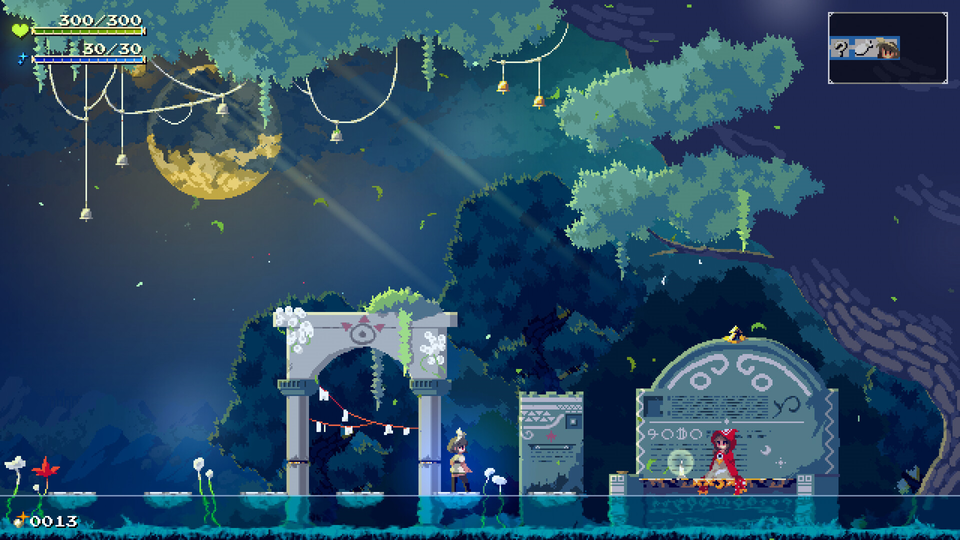
As far as stories go, it does what it needs to do, pushing Momo where she needs to go in the levels, but on the whole, the story is your standard hero's journey, with Momo setting out to defeat evil, gaining the power to defeat that evil, then defeating that evil. However, it does have little moments of intrigue, like the true identity of one boss, showing that it has the potential to present an enriching, engrossing world, but it only ever skims the surface of what it can do. For instance, one boss arena has a giant sword embedded in the bog. There's zero other context for its existence, so that in itself births so much intrigue, making me wonder if the sword was an actual weapon wielded by a long-gone giant or was a monument like Norway's Sverd i fjell. Momo does have occasional run-ins with an archaeologist who'll give spiels on giant relics, and while this does bring lore into the worldbuilding, I also can't recall a single thing she told me.
Maybe it's because I'm the type who has the habit of zoning out during lectures, but nothing the archaeologist said stuck. Listening to her was like listening to an avid cricket fan ramble at length about last night's game when I don't know the first thing about the sport. While I respect the effort to build up the world's history and its inhabitants, much of her exposition is rudimentary facts divorced from the main story, and because of its lack of relevance—barring one tidbit from the world creation myth she shares—along with its lack of depth and lack of overlap, none of it had the substance to set in my mind.
What makes the lore from games like Dark Souls or Hollow Knight so immersive is that they're telling stories. Sure, it's a lot of fragments that require a good deal of investigative work to piece back together, but each weapon and item you pick up has a history preceding your arrival, making the world, through one or two lines of extra text, feel much grander than the bridges you span and the zombies you kick off those bridges.
This is the zest missing from Momodora V's lore. Don't tell me fairies have centuries-long lifespans. Show me enemies sitting in the springs of their homelands coming back to life immediately after I murk them. Regale me with the tale of how a fairy long, long ago used a magical conch shell to wall-jump up a mountain and beg a god for wings, and that's why fairies today can fly. This would also layer on another reason for why Momo receives a magical conch shell beyond a basic reward for heroism: it's useless trash collecting dust in the fairies' broom closet, so they pawn it off on Momo. Little nuggets like these would be the fertilizer that would've made the world of Momodora V that much lusher and richer, and the thing that gets me is that Momodora IV had little stories like this. They weren't backstory or world lore, but side characters turning the pages on their own stories independent of what that game's protagonist was up to, such as the traveler searching for his companion, only to learn of their unfortunate fate. None of these NPC side stories are complex, and there aren't many of them, but each does its job to remind the player there's more to the world than the character they're controlling, as well as reinforce the sobering tone Momodora IV carries throughout.
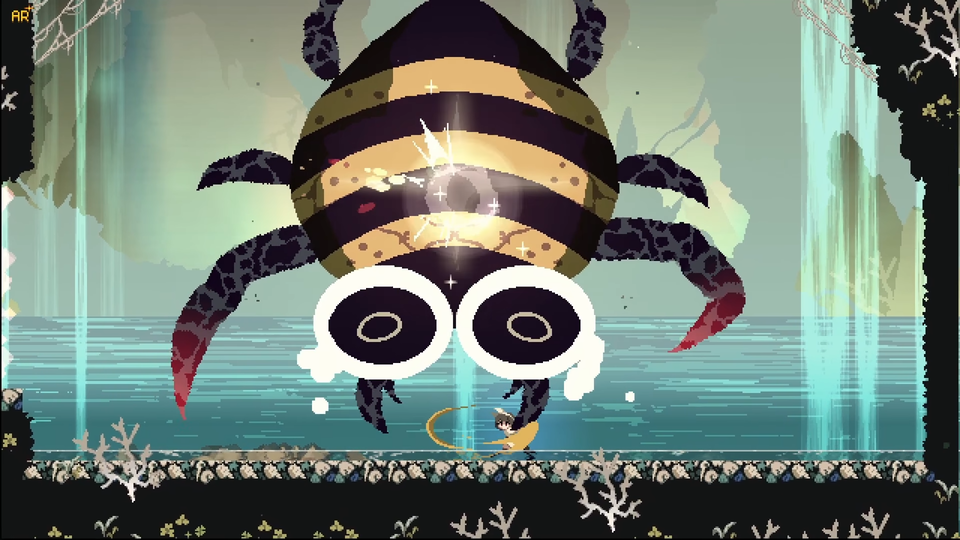
The tone of Momodora V is much more chill despite the demons popping up like dandelions. Areas are brighter in color and lighting, and the music is more pleasant, and it isn't until you reach the scene of a genocide that the tone dips back into Momodora IV territory. But even then, I didn't feel the same oppressive atmosphere in Momodora V that I did in Momodora IV. The latter takes place in a city under siege, so just about everywhere you went was a human settlement or edifice occupied by demons that had moved in like termites. That disparity itself is a reminder that things are cattywampus. By contrast, the former takes place largely in the wild, so demons out in a bog feels more like animals in their natural habitat that I'm mowing down because they're in my way to the nearest piece of heart.
If you ask the layman what genre Momodora IV fits into, they would say fantasy, and while this is true, at its emotional core, I would say it's a tragedy. Death sits around every third corner, the foxholes the cityfolk burrow in feel like temporary refuges, and don't even get me started on the ending that reframes the purpose of your entire journey. Every bit of Momodora IV's presentation adds to or reinforces its narrative that the city is a waking nightmare and there's no dream to fall asleep to.
When pressed with the same question about Momodora V's emotional core, I'm at a loss, and I can't help but sense that so is the game. It begins with an ominous premonition and does feature two areas blackened with the erasure of their populations, but in between is untouched nature and characters acting like the world isn't on the precipice of destruction. It even foreshadows a tragedy that never comes to pass.
Momodora V is caught between reining in the darkness of its predecessor and capturing the darkness of its predecessor, so it splits the difference, but it has the same effect as wearing one brown shoe and one black shoe to your cousin's wedding. All this said, Momodora V, and this extends to its predecessors, are games you play for the gameplay, with the story being a nice little bonus, and if you take V's story for what it is, it's serviceable. However, it's trying to tell this moody, epic hero's journey, but between the inconsistent tone, stiff dialogue that makes the characters sound like robots, and lack of risks, it fails to put in the needed legwork for its desired narrative.
Combat
Though Momodora V fails to tell a good story or provide engaging lore, if you're like me and picked it up for the gameplay, you'll have a much more pleasurable time.
Combat carries over from IV, so slapping enemies with a giant leaf or picking them off with a quiver of infinite arrows should be second nature, but the combat's also seen some refinements. Big changes include cute li'l critters that'll follow you around and occasionally restore your health, drop money, or throw punches at baddies. A ton of them are available, but each is limited to one of the three effects I just described, so there's rarely a sense of obtaining something unique or useful when coming across a new critter, and which one I wanted as my helper was dependent on the choice between a chibi NPC, a baby monster, or an abstract cube.
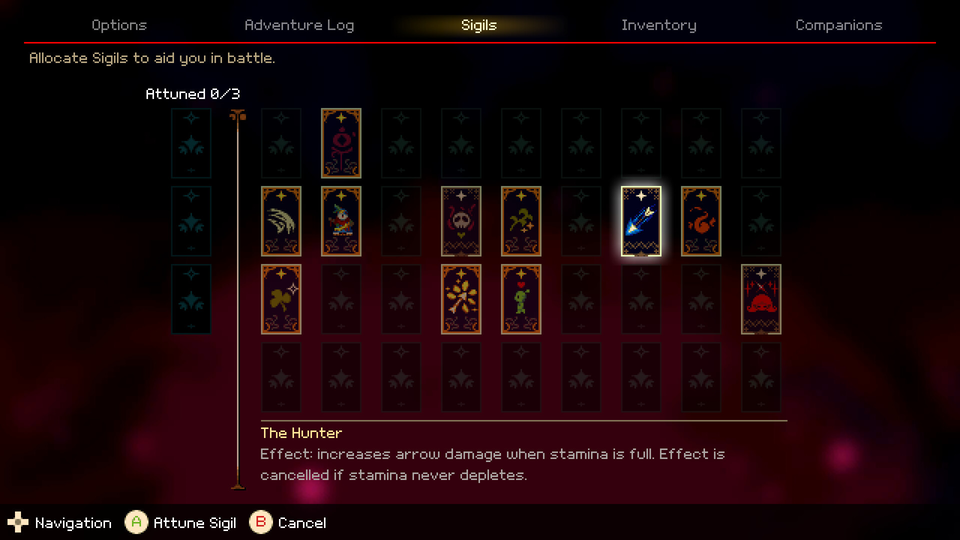
Another big inclusion is the expansion of equipable perks, which were on the scarce side in IV. The most you could do to power yourself up in the prequel was lace your arrows with poison, bloodlet for a temporary strong arm, and give your attacks some literal flare. It did the job, but the options were lacking. Momodora V, however, is not lacking, giving the player well over 30 perks, granting that freedom IV is lacking. Some perks I only used in single instances, and most I didn't bother with at all, but so many options are available that the player can tailor their kits to specific playstyles, and the only cost is some of the player's time and curiosity as they explore.
For some examples of what I made, when I was exploring a new area, I kitted myself with a perk that restored my health when picking up the money enemies drop, a second perk that made my critter drop money more often, and for future investments, I had a third perk that increased the value of each coin I picked up, (an investment that went to waste when I bought the very few items for sale and still had 6,000 coins jingling in my purse). And then when I faced a boss, I switched over to a more offensive kit, which included such specialties as swords that would shower down on my enemies, extra arrows per shot, a giant sword that would lance my enemies like I were Vlad the Impaler, and, depending on how spicy I was feeling, arrowheads that went kablooey. The system's nowhere near as expansive as something like Final Fantasy VII, which allows a character to auto-revive upon death and simultaneously drop a tactical revenge nuke, but it did have me occasionally fussing if I should top off my kit with turning my leaf into a giant boomerang or if I wouldn't be better off with faster arrows. The system could do with save slots for kits. It was a hassle having to swap from my traveling kit to my offensive kit before boss battles and back after.
These are all mechanical improvements. Combat itself, though almost identical to IV, has seen a great deal of spit and polish, and the key term is game juice. Attacks have plenty more oomph, shaking baddies more, shaking the screen, even, and slowing the time scale on big hits, and baddies explode into a fireworks display of particles when killed. Momo's also much more animated when using her bow, twirling around as she loosens arrows, as opposed to standing there plucking the drawstring. And then when you combine the juiced-up combat with the perks, it's hard not to feel on equal footing with a demigod when your attacks also summon a hail of swords upon your enemies right as you flash-forward to sock them upside the jaw.
All this extra juiciness does have its drawbacks with one late-game boss, specifically the extra particles. While the added glitz, glamour, and flash make for great-feeling fights literally the remaining 99% of the time, they become an intrusion against this specific boss, because not only is this boss quick on their feet, they come with their own array of particles. Far and away, this boss ranks top of the list in terms of difficulty because I lost track of Momo in the charlie foxtrot constantly, and by the time I found her, I was below 20% health. Overall, particles are a net positive for gaming, and while more particles can and do make for better-feeling games, there's a threshold where too many particles impedes on the player's ability to play the game. As I said at the top of this paragraph, this is only an issue for literally 1% of the playtime, but it's still a note of warning to intrigued players that unless you've got superhuman tracking capabilities that'll keep your eyeballs glued to Momo through rain, snow, sleet, hail, and a tornado, the perk that becomes more effective the more you die will be your best item by the time you finally put down this boss.
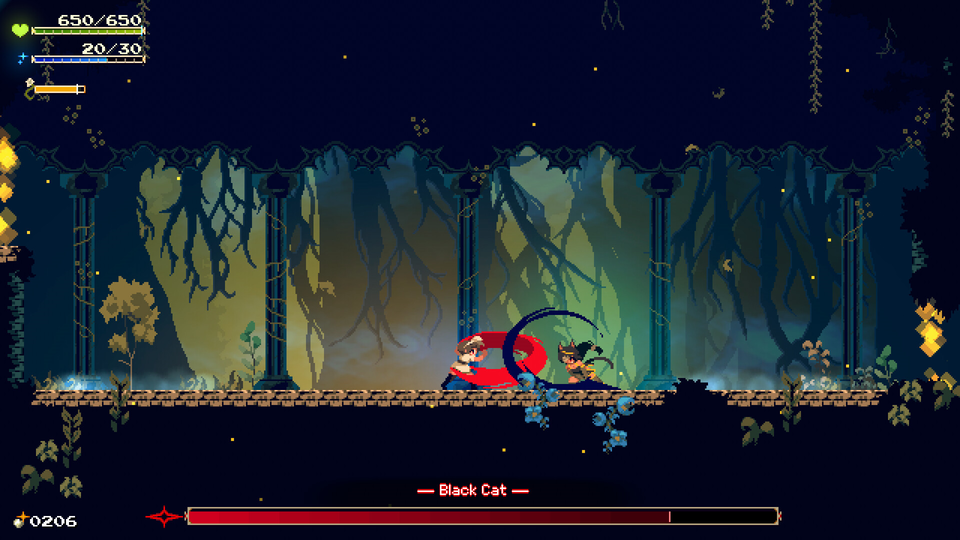
Levels & Design
For the first three or so hours of Momodora V, I was having myself a grand old time hiking through levels, collecting goodies, and pimp-slapping any baddies in my way. It's nothing standout-ish as far as metroidvanias go, but the tight controls and difficulty scaling that guaranteed my ventures were tough but not a challenge gave me nothing to complain about. But then came a certain point in the game, right after I received the magical conch shell, that I noticed a discernible drop in quality and would later realize that Momodora V, despite possessing the trappings of a metroidvania, seems embarrassed to be one.
After obtaining the magical conch shell, Momo has to backtrack through two whole areas to arrive at her next destination. Backtracking being probably the most common complaint in the genre, one would assume it's the very act of backtracking that grinds down the pacing of this game, but Momodora V has a fix to avoid the monotony of the backwards rowing, which is to do like Hollow Knight's Infected Crossroads and spruce up the hike back. The problem is that this fix felt like clipping my toenails with the claw of a hammer.
New enemies have taken up residence on the return trip, some of which were easily the most annoying in the entire game. Being giant worms, you'd think hitting them would be like shooting fish in a barrel, but they move so fast, they singlehandedly plummeted my bow's accuracy into the single digits, not to mention their huge health bars, so they take forever to kill. One room is seared into my memory because I needed to ascend to progress, but the way up is narrow platforms swarmed by these giant worms, and any time I tried expediting their deaths with melee attacks, which did more damage, more often than not, they would brush against me, and I'd plummet to the bottom, forcing me to start over. What should've been a twenty-second flyover turned into this minutes-long war of attrition wherein I whittled down these worms' healthbars. A smarter player I watched on YouTube got potshots in when a worm dove near, but it still looked like a tedious affair whacking a worm, waiting, whacking a worm again, and waiting some more. And the kicker is that you can't even detour around the worms because sections of the map become barricaded, funneling you along a predetermined path. At this mark in my playthrough, I thought levels would be opening up more, but funnily enough, this forced linearity is a microcosm for the game as a whole.
Map layout in Momodora V is more akin to metroidvania staples, being like a city with wards that abut and loop in on one another, compared to IV, which was more of a highway with exits onto small towns. But that's all that's metroidvania about the map design because, strangely, it's IV that allows for free-roaming exploration, whereas V has a strict path the player has to follow. Any deviations are the player coming to a fork in the road, choosing the left foot, coming to a roadblock ten steps in, then retracing their steps back to the right fork. Of all the mapped areas in the game, only one is optional.
It gives V this closed-off feeling, like instead of touring a hip city, to use my previous analogy, you're a contractor who can't enter foreign countries without the appropriate paperwork. A linear experience isn't a bad experience, and I'll even dare to say a linear experience in a metroidvania can still be enjoyable. However, it does come across as disingenuous when a game in the genre renowned for free and open exploration drops you in a switchback and demands that you not step over the ropes.
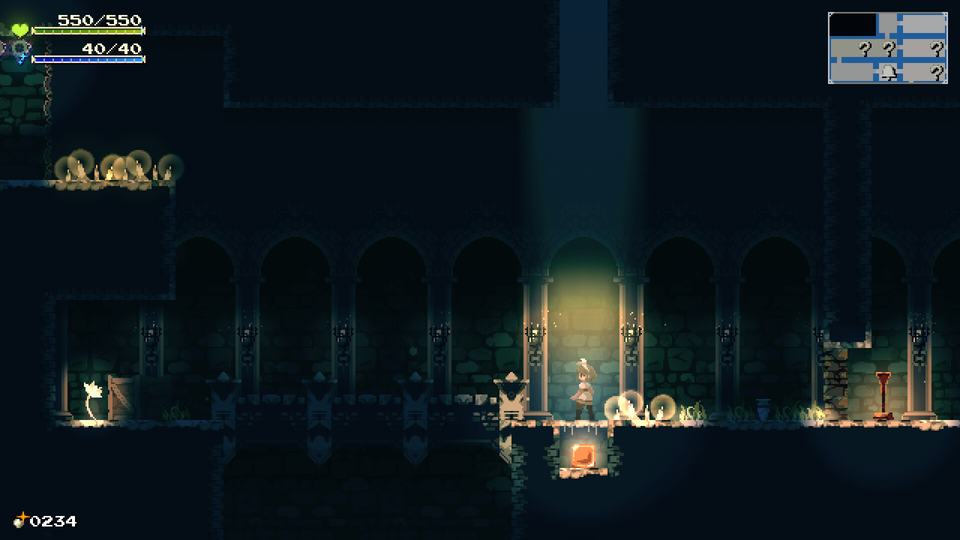
A staple of the genre are secrets, and V isn't in short supply of these. However, while most metroidvanias typically hint at secrets through environmental design, V slaps a giant question mark on the map. As soon as a square fills in on your map, if there's a secret of some kind, the game will automatically clue you in. I didn't mind this because it didn't require me to access a guide down the line to find what I missed, but I think IV does it better because that hint box is opt-in only. IV's hint system could use some accessibility revisions since it's sound-based, so deaf players are out of luck, but for the general audience, they have the option of receiving or not receiving hints, whereas V will shove the hint into your hands whether you want it or not. Of all the complaints I've levied at the level design as it relates to other metroidvanias, this one is the most benign. But it's just another way where Momodora V tries fixing faults inherent to the genre like a clumsy anime girl.
Up to this point, my take on Momodora V has been fairly critical, the natural conclusion to which would be a drab score, and I should take the time here to point out that on its surface, if you're just picking up and playing V without putting much stock into its story, level layout, how things flow, and so forth, it's a competently assembled and enjoyable experience. But when you dig down, you find a lot of unsavory critters, and if you pop back up and view V from afar, it's not building with much ambition.
To use an example, the player throughout can find berries that increase their health, magic, and stamina. Also throughout, however, they can also find berries that have no discernible effect. You even get text reading as much, ending with an ellipsis to add that touch of ominousness. I figured after eating enough at some point, Momo would black out and wake up imprisoned or transformed into a frog or something. This would make it the third time in a row the developer has used this trick, but a recycled trick is still better than what Momodora V gives, which is nothing. This would've been a great chance to punish the player for absentmindedly doing something because it's a video game and players eat obviously poisonous plants to see what happens. That Momo specifically says to an NPC at one point that some monsters disguise themselves as tasty-looking berries and then you never come across a single berry-disguised monster is such a poor demonstration of writing ability, I have to wonder if it was even remembered that line was written in the first place. I did locate from Word of God, series creator rdein, that these berries increase luck, and while that's fine and dandy, I have to ask why go about it in such an enigmatic way. Telling a player a berry increases the luck stat may be boring, but it's not a payoff where the check's blank.
Where else Momodora V is lacking ambition is in its level design. Recall how I said V is nicely built but not breaking any ground. Part of this is because the entirety of the game is the same gameplay loop of explore area, slap baddies, find goodies, fight boss. While this is a satisfactory loop, there's next to nothing to give the player a rest or change in pace, and I realized while doing one of the game's few platforming challenges that it could do with more platforming challenges. Of all my memories of Hollow Knight, the one that stands out the most vividly is stumbling into a labyrinth that demanded I pogo-hop to reach a collectible, and it was an amazing test of my skills and a great shake-up in the moment-to-moment gameplay loop. Hollow Knight remembers that half of its core experience is platforming and puts that to full use with its platforming challenges. What's funny about Momodora V lacking more platforming challenges is that it introduces more platforming abilities over its predecessor. We've lost the aerial dash from IV but gained wall-jumping, a sprint you can cannonball out of, and, late in the game, enhanced platforming when you go Super Saiyan. Any of these, especially combined, could've made for some great or even amazing platforming challenges, but all we're left with is jumping we can't fully utilize.
Another glimpse of potential shimmering from Momodora V is a talent for puzzles. For an accurate count, it's just one puzzle, but it's so brilliantly designed, I'm writing this paragraph petitioning for Momodora V to include more puzzles. The setup goes like so: obstructing Momo from a goody is a door, and etched onto the door are icons that just barely resemble the symbols for the perks, with no other clues or hints. What makes this puzzle work so well is that it provides just enough information for the gears to get spinning in the player's head, but that information exists in a fog, so there isn't a clear line of sight that the apparent solution is the correct solution, and the solution, just as well, is an action the player has been performing the entire game, just not in this manner. It makes me wonder what other sorts of puzzles the dev team could've cobbled together if they gave the game's mechanics some sideways looks.
They did manage this with some late-game bosses that are inventive in how you defeat them, such as one boss that will die on its own if you sit tight. This fight could've been more creative in how the boss dies on its own, like it hurdles its limbs at the player before kamikaze-ing its heart, but the dev team at this stage, I imagine, were short on time or saw the finish line in sight and just wanted to reach it, so I can't picture it was a front-burner priority to distinguish a boss that was a palette swap of its three other twins. The one drag is that this creativity is only applied at the end of the game rather than earlier, and that could've gone a way toward flavoring the other boss fights. I wouldn't say Momodora V has bad bosses, but I've recently played the Rubinite demo and Touhou Luna Nights, which both feature amazing fast-paced boss battles that fully utilize and demand mastery over the game's mechanics, and comparing them side-by-side, Momodora V's boss battles look like noodles boiled in water and not even served with butter.
If I had to peg down the distinction, I think it comes down to synchronization between the boss and the player. I said before that a Rubinite boss is a raging bull you, the matador, have to dodge. A Touhou Luna Knights boss is rainfall you need to duck and weave through. A Momodora V boss is playing Red Light, Green Light while the player is a bully trying to take their lunch money. The combat flow of V is simply avoiding the boss while chipping away at their health bar when allowed. It's about as stock and standard as boss battles go, which is why when I reflect on Momodora V's bosses, all I can say is that they were all right, except for the one that was like trying to fight while floodlights flashed in my face. Funnily enough, that's the sole boss battle in the entire game where the player and boss are in perfect synchronization (except for maybe the post-game boss I couldn't beat), and it's because the boss fights like the player would: constantly on the move. To think that if that battle wasn't a maddened cacophony of blinding glitter, I might be praising it as an amazing boss fight.
The Other Momodoras
Heading into this review, My intention was to review Momodora V and then call it quits. However, in the middle of my playthrough, I checked out the Steam page again and read how V, though it can be played as a standalone title, is the closing chapter on three other Momodora titles, i.e., the ones I haven't played. So while I had my attention and interest on Momodora, I figured I ought to take a journey through the series's roots and see how the titles have evolved and what matching threads I could tie.
Momodora I
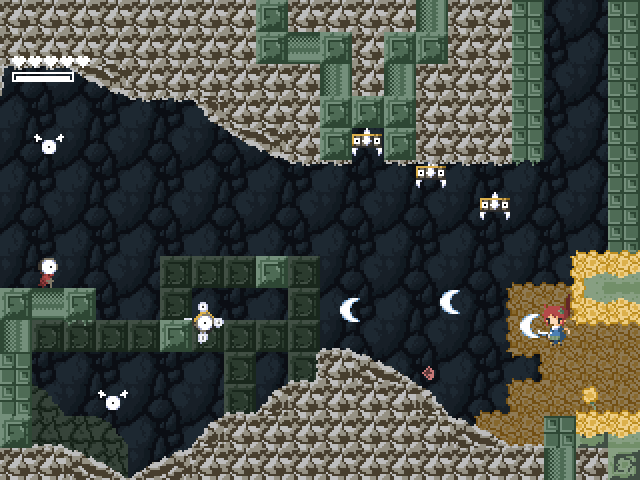
Ordinarily, the best place to start with a series is at its very start, but curiously enough, the series's creator is embarrassed about the first title and urges players to skip over it, which is a sentiment I can't say I don't empathize with. And after giving the game some of my time, I realized I probably should've respected the creator's wishes.
Momodora I carries an old-school NES feel in its graphics and its soundtrack, but this is only half-true for its game design. The player can only restore their health at save stations, but if they touch spikes, it's back to the most recent save. The other half of the truth is that some of the game design comes not as an attempt to capture that hardcore NES gameplay, I surmise, but from a lack of established design principles.
There're a lot of little things about the design that suggest the team programmed the gameplay to meet basic criteria and didn't refine it. For starters, there's no coyote time, which I learned when I went to jump and plummeted into spikes on more than one occasion.
Tileset sprites have a contrast problem where it's sometimes difficult to discern what's solid and what you can pass through. The detailed tiles in the final area are also rough to look at, and their color scheme, combined with the myriad of enemies and particle effects, makes it too easy to lose sight of your character.
The hitbox on your character is literally just that, a box encompassing the full sprite. If you study the hitboxes on more polished titles, the developers will lift a leg for the player by shrinking the player's hitbox, to where it's often smaller than the sprite itself. So the consequence of this full-sprite hitbox were frequent moments where I would stand beside an enemy to attack but wind up taking damage because even though our sprites weren't in contact, our hitboxes were overlapping.
A combat feature I often hem and haw over its worth is player knockback. I would sit on the fence, not sure which side I should jump down to. I had been leaning toward knockback being a negative, since it's annoying when an enemy sends me hurtling off a platform or, better yet, prevents me from landing on a platform in the first place, but Momodora I taught me there is utility in player knockback because it would've diminished the trouble of overlapping hitboxes. Knockback on enemy contact would separate the two, preventing the player's HP from draining.
The game does have a workaround for this to keep the player from ever getting near enemies, and it's the inclusion of guns, which is a curious, since Momo in Momodora V ponders what a firearm is, yet her friend in this very first game was blasting baddies like she was fighting the alien invasion in Contra.
What else gets me about loading up the player like the first Momodora is a boomer shooter is how it contrasts with the starting weapon. The series's signature weapon is a leaf, and while it's become iconic in its own right by this point in the franchise's run, the first game didn't seem confident players would take too well to spanking bad guys with a giant maple leaf, so it empties an armory as a distraction. This decision is neither good nor bad, unless you're a diehard Momodora fan who swears fealty to the maple leaf, but it does make looking back at Momodora I like checking out early Yu-Gi-Oh! and learning its plot hinged on challenging punks to air hockey and setting the loser on fire.
All this said, how did my look-back on the series's origin fare? To be frank, I didn't finish it. I called it quits when the forward path in one room loaded in too tightly by a single pixel, preventing my character from squeezing through, but this was just the straw that broke the camel's back. I was frustrated as it is with my controller setup, since this game requires third-party software to play with a controller, my preferred gaming input, but the software refused to open back up after I closed it once, and to top it off, my controller itself decided functioning wasn't worth it anymore and petered out. So I dropped the game and watched a playthrough of the rest on YouTube.
I did play enough to get a general vibe of the first Momodora, and despite its many faults, it's not a bad game. Like any game, it does require an adjustment period to its specific feel, and once you've got the hang of things, it's a decent action-platformer to burn through when you've got an hour or two one night and are peckish for a challenge.
Momodora II
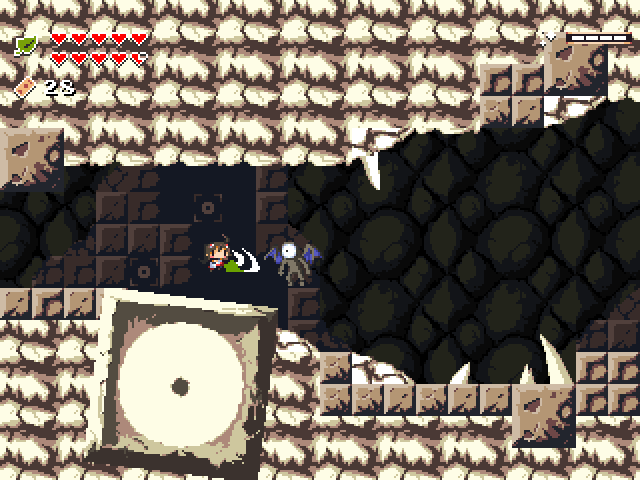
After playing and then watching Momodora I, I jumped right into its sequel, Momodora II, and this is where the series's identity takes on its familiar mold. Rather than a linear subterranean descent with the occasional fork so you can pluck flowers, Momodora II is a proper metroidvania, with distinct areas and roadblocks requiring specific keys before you're allowed past. Save stations are now the series-familiar bell towers instead of nondescript geometry, and it dumps the guns in favor of the more fantastical talisman. In addition to paving the foundation for future titles, it makes alterations to the debut's gameplay, though results are mixed.
Good Change: Movement has seen a good deal of tender, love, and care, bestowing us with jumps that aren't slow or stiff.
Bad Change: From what I can tell, coyote time still isn't a thing, but I didn't have the same problem dropping off platforms, which can likely be attributed to having grown accustomed to these early titles' platforming.
Good Change: Enemies occasionally drop hearts, so you don't have to chuck a uey to the most recent save point just to heal up.
Bad Change: Your ammo's finite. This isn't too big of an issue, since enemies aren't frugal about drops, and the only way you'll run out is if you're too trigger-happy, but it is interesting to note how this is the only entry in the entire series without unlimited ammo.
Good Change: Spikes aren't insta-death, which is always a fantastic change, and triply so, since the last level incorporates literal mazes of spikes.
Bad Change: There's still no knockback, which synergizes with the fact that...
Bad Change: Your melee range is pathetic. You have to get close enough to baddies that you can give them a kiss on the cheek before deleting them from existence, putting yourself at risk of an easy collision. That your post-hit invincibility is longer and that your hitbox is, I think, smaller do remedy this, but your diminished attack range is liable to be the first thing you notice, as it was mine.
All in all, it's a fairly even mix of good and bad changes, though half the bad changes aren't so bad, and the good changes are actually great changes, so I did enjoy playing Momodora II compared to Momodora I, when I was never more than lukewarm, though there were parts in II for which I was never more than lukewarm.
For one, the music in this game is loud. Like, really, really loud. The first game does have some great music—and while I'm bringing up music, all three of the first games have great soundtracks—and it does the Xenoblade Chronicles thing where players compliment the music, so the games go, “You like our music? Then let's blast out your eardrums!!” And Momodora II has no in-game option to lower the music volume, so you'll have to do the old-fashioned trick of lowering your PC's volume.
The builds of these first two titles are unstable, I found. While you can sit down and play them without issue, whenever I paused them for too long, i.e., one minute, they tended to crash and refused to shut down unless I force-closed them through Task Manager.
I would advise against reading the ReadMe file in the itch.io download file or at least looking immediately at and only at the control scheme because this document contains blatant end-game spoilers, and I'm not sure why. Momodora II has as much story as the first title, setup for why you're on your adventure and the consequences of beating the final boss, but I don't see why the synopsis couldn't have been something more generic or vague that won't give up what's supposed to be a twist ending for first-game players.
Getting back to the gameplay proper, though Momodora II advertises itself as a more exploratory game compared to its predecessor, it's about as linear as Momodora V. Sure, the map itself might be nonlinear, but the path you'll traverse it is set in stone. Like I said for V, it's not a bad thing that the game progresses in a linear fashion, but player agency is minimal when the extent of permitted bushwhacking is jumping to the other side of a brook for a health upgrade.
While the topic's on the map, the in-game map has numerous inaccuracies, with incorrect room boundaries, and the map stops displaying save points for the last two levels. While incorrect boundaries only require a tiny bit of common sense to figure out, the missing save point markers is more of a pain, particularly for the final area, which is a maze of rooms spreading out and looping in on each other in random fashion, and if you're low on health and need to retreat back to a save station, you'll need either a great memory or sheer dumb luck navigating your way back. Areas are small, so the map has that going for it, but when a map starts off displaying locations and then stops after a certain point, it makes the map come off as vindictive because I never gave it a proper thank you.
What was nearly my breaking point for this title was the second boss battle. This game only has three bosses—two if you're counting the second as a rematch—and my very first thought when fighting the second boss was “How am I supposed to hit her?” The first boss battle wasn't a walk in the park, but there were quite open windows to get hits in. For this rematch, the boss is constantly on the move, constantly attacking, giving the player no opportunity to go on the offensive. You do receive a mobility powerup that allows for air-dashes, so I thought that was the key to winning the fight, but it's purely a defensive tool. After dying no small number of deaths, frustrated, I watched a video of this fight to see if there's a trick to winning, and there is: slowly whittling down the boss's health by getting one or two hits in at a time. In other words, the thing I had been doing, just not successfully. And when you die, it isn't as though you just respawn and start over. From the nearest save point, you have to walk several screens to the end of a corridor, grab the powerup, turn around, and only then will the boss drop in, and also keep in mind that this corridor is occupied by baddies who live for chipping away at your healthbar so that you're at even more of a disadvantage for the boss. I eventually stopped killing the baddies and just ran past them, which resulted in one attempt when a baddie followed me into the boss room, so now I had to deal with them and the boss's bullet hell. This boss battle was so aggravating, I probably wasn't more than three more deaths from calling it quits. But I persevered, finally gave that lady the spanking she deserved, and was on my way to the game's conclusion, sort of, but not really.
Despite my mentions of the final area and the ending, I should note that I didn't finish this game, either. The final boss requires that you beat it at a match of tennis, which, it turns out, I'm awful at. But it was getting late, and I didn't feel like picking this game up the following day for a 15-20-minute boss battle, so I did like before and watched what I missed on YouTube.
While Momodora II is a great improvement over the first title, there was still plenty of work to do as far as crafting and polishing a positive experience, and the third title would herald in that positive experience.
Momodora III
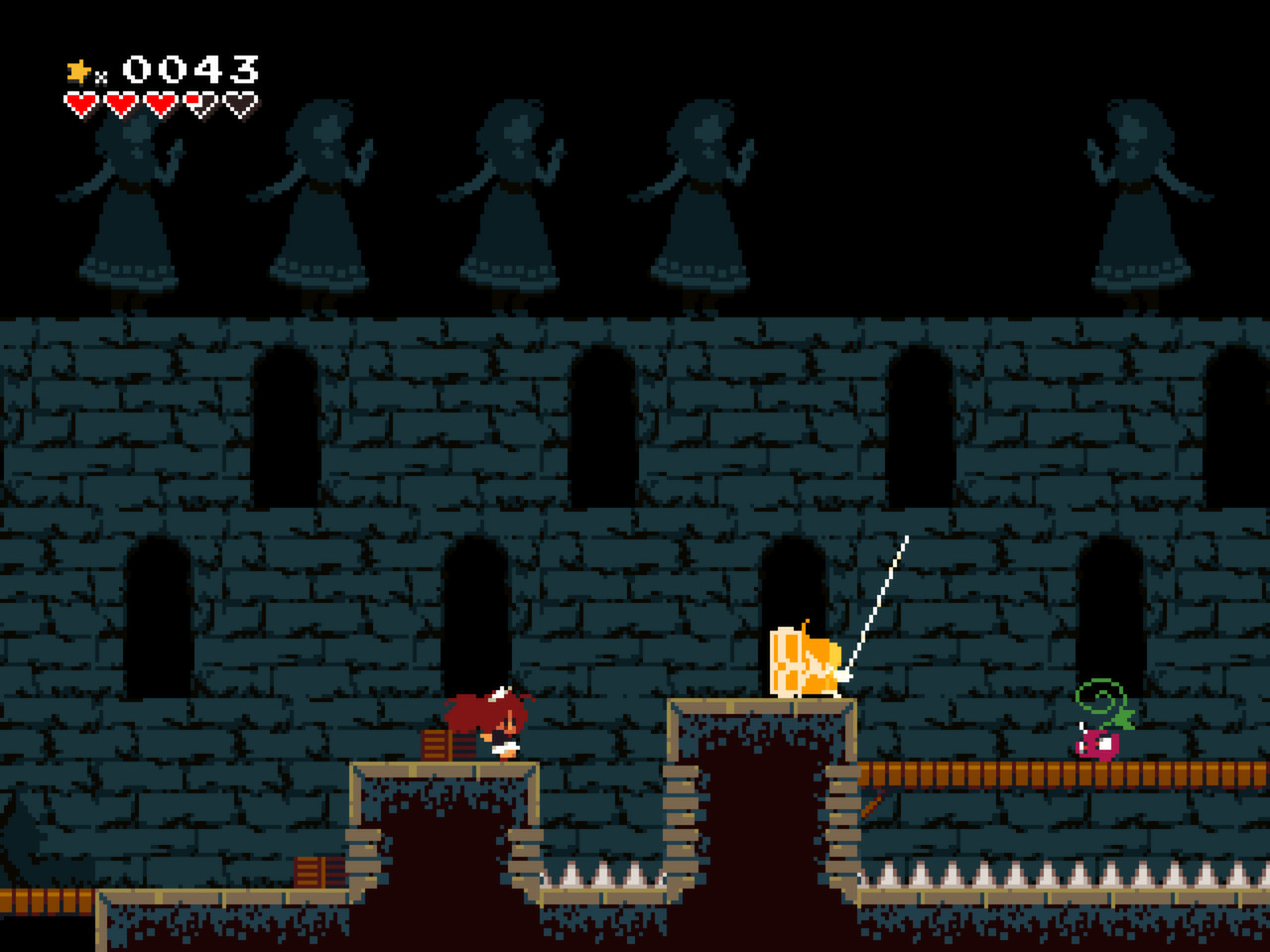
The final stop on my look-back quest was Momodora III, the earliest title available on Steam, and the first Momodora title with a cost of admission. It's a $2 USD price tag for a 90-ish-minute playthrough, but since you'll easily spend five times that for a movie ticket, I say that's a bargain.
Rather than a singular protagonist, Momodora III gives you the option of playing as either protagonist from the first two Momodoras, Momo or Dora. Functionally, they're identical, but since I had spent 10-odd hours with Momo in Momodora V, I elected to play as Dora, and I have to say that up until the release of Momodora IV, III hands-down had the best game feel.
Movement is so fluid, attacks are quick, with a healthy range, and when an enemy touches you, you get knocked back. Never did I think I'd be so happy seeing my character go hurtling backwards after an enemy steps on their little toe. It's tricky adequately describing the differences in how movement feels, since some of the differences are more subtle than not, and even to a sideline observer, they look pretty alike, but when I jumped to III from II, my first thought on how it controlled was that it felt like the most modern title.
Despite II laying down the foundation for modern Momodora and III laying down more concrete with additions like equipable items, III gets experimental with its framework, returning to the linear levels of the first Momodora, including random little challenges and Easter eggs, such as reaching a character in under 30 minutes to prevent her death, and even tweaking your ranged attack and how you save. Unlike the previous Momodoras and the Momodoras that came after, in Momodora III, rather than thwacking a bell to save, you have to press Up to interact with it, which is impossible on a controller. Even though this is the first Momodora title with built-in controller support, actions done via the Up Arrow key just don't work. For reference, I use an Xbox One controller, so I don't know if this issue exists with other controllers, but this was my experience, meaning that of the five Momodora titles, the majority of them have inadequate controller support.
If your standard input is keyboard, none of my controller troubles will be your troubles, but if you're like me and like the feeling of a controller in your hand, there's no getting around the hoops hanging between you and a basic gaming session.
When you do get settled into a session, it's your good-old Momodora. You run forward, you wallop baddies with your giant tree leaf, you occasionally fight a boss, and then you enter the next area and repeat this cycle until you beat the final boss, and I am happy to report that I did see III to completion, though the game was trying my patience at points.
Early on, you can find an item that allows you to summon a shadow clone of yourself, which is simultaneously your biggest help and your biggest hindrance. When it's attracting and swatting common enemies, it's great, and it'll lend the same hand for bosses. However, it's extremely aggressive with bosses, and its attacks produce so much screenshake that it became next to impossible to tell what was going on, and I ended up ditching it altogether for one boss because I couldn't discern the boss's telegraphs or precise location, or even mine at times. I also swear the shadow clone's AI changed halfway through because during the first half, it would dash ahead and beat up enemies like it was Jerry's cousin Muscles, but then for the second half, it clung to my side like a shy toddler.
I would say the second-to-last level is the worst, but really, it's just two distinct rooms that were getting my goat. They introduce bomb-throwing grunts, which is a standard in the later titles, but the key variance is that bombs in IV and V just do a lot of damage, and bombs here in Momodora III kill you instantly. The game was high on schadenfreude when an out-of-reach bomb tosser was lobbing explosives onto the platform I was standing on while another lobbed bombs in my jump path off that platform. This strike zone by itself killed me more times than the boss in the previous room. Also, this is the section of the game when I learned that spikes returned to being insta-death. You can bet I had a sailor's mouth when traversing these two rooms.
Despite my occasional frustrations with Momodora III, particularly its latter half, this entry in what I suppose you could call the retro era of Momodora is easily the best and most polished, and even though the games were flip-flopping on what they should and shouldn't have, I do respect the series for not being afraid of experimentation, and all this tweaking and refining would result in the series's golden child.
Momodora: Reverie Under the Moonlight
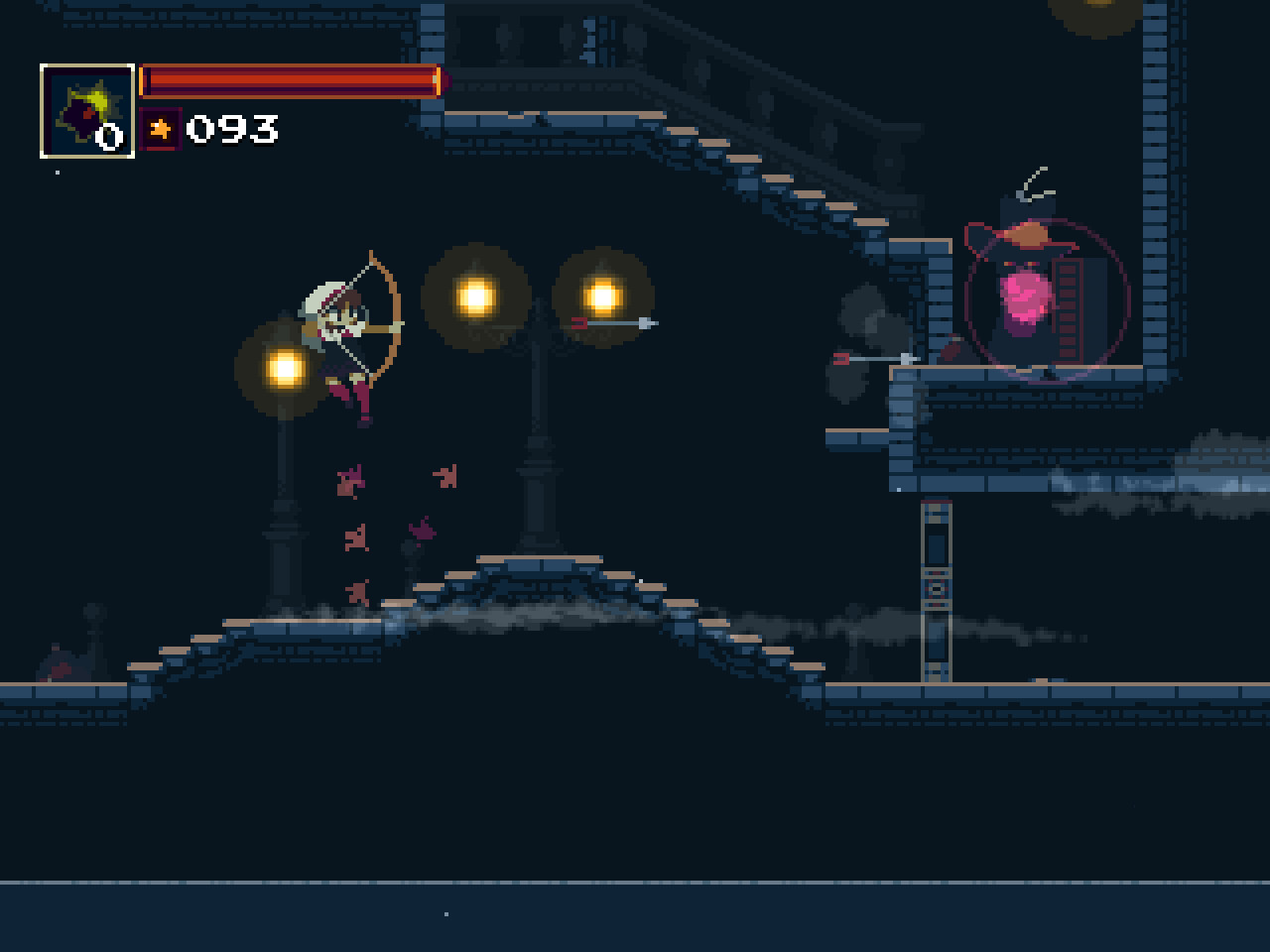
Here's where Momodora enters its modern era (since I made up the retro era tag on the fly to concisely refer to the first three games). Here's where Momodora also pulls a Hollywood and stops numbering its franchise entries, though I imagine it's justified here because Momodora: Reverie Under the Moonlight is a prequel to the retro games, taking place a full four centuries earlier.
Going into this retro section of my review, I wasn't planning on covering IV, but since III sprinkled in a bunch of lore nuggets, and because I've been massaging IV's feet this whole review, I decided I'd take a look back at the title that put this series on my radar and see if it does live up to my memories.
Returning to Momodora IV after playing Momodora V and Minoria, another title by the same developer, the first thing I noticed was how stiff the protagonist is. She jumps considerably slower, and even though she begins with a double-jump, it has the same lift as taping cardboard sheets to my arms and giving them a flap. I wasn't two minutes into my replay and already I was wondering how I had enjoyed this game a few years back. But by the time I had beaten the first boss, I had adjusted to the protagonist's locomotion, and it was smooth sailing from there. Well, smooth for eighty seconds, when I ran into a batch of new enemies that proceeded to pummel me, swiftly reminding me how difficult this game is.
I had elected the hard difficulty, figuring I would breeze through the normal difficulty since this was a replay and I therefore could use a challenge, and, boy, it sure was a challenge. Aside from the first Momodora, this is handily the Momodora most likely to hand you your rump on a silver platter for every course of a five-course meal. Enemies are fast with their attacks, and on the hard difficulty, they needed just two shots to put the protag down, and then the bosses would have an attack that would one-shot her. It had been a while since some boss battles had frustrated me this much, but the great thing about Momodora IV's design is that if some baddie's giving you trouble, you have the luxury of buggering off.
Of the three Momodoras that incorporate a metroidvania-style map, IV is the only one to adhere to the exploratory design of the genre. The game will guide you in a certain direction at first, to inform on the foundational gameplay loop, but once you reach a specific stretch of avenue, you're free to take any of the attached exits. The game opens up so early, in fact, it makes other metroidvanias seem glacial in their pacing, though Momodora IV needs that extra boost because it's a surprisingly short journey. The game's beginning its wrap-up by the three-hour mark, which is a real shame because I wanted to keep exploring.
Of the many things Momodora IV does best, it would have to be atmosphere. I mentioned earlier how drab and dreary IV is overall, and this return reminded me that it's not just one shade of dark. The city catacombs are this ill-lit, ghastly network of passageways taking on water, if not entirely flooded, with music that makes this man-made place feel otherworldly. Underneath the monastery, lain over with eerie music, are heated chambers whose function is a complete enigma. But then there's the memorial park, the place with the brightest palette aside from the forest you begin in, but the colors here are muted, and the music is this calm, reflective piece inviting you to spend a moment to sit, think, and just be.
As you might've noticed, the score is a huge contributing factor to IV's atmosphere, instantly and easily transforming the vibes of the place on its notes alone. The soundtrack isn't winning a nomination on anybody's Best Indie OSTs awards, which is probably why I didn't acknowledge it my first playthrough, but the composition pulls phenomenal work at setting the mood in tandem with the art and writing.
Funnily enough, the area with arguably the best atmosphere doesn't even have any music. The city proper is just a few roads, canals you cross over, and buildings you dip in and out of, but there's a palpable tension in the air the instant you arrive, as monsters litter the streets and residents take shelter indoors. But what really pushes this setting to the top of my Best Atmosphere chart is the striking artwork of the castle in the background, its profile only visible for the moonlight highlighting its outline, and the royal fortification is so massive, it doesn't even fit on the screen. I'm sure everyone who's ever reviewed this game has praised its pixel art to Shitterton and back, and to me, the centerpiece that not only exemplifies the artistry at play, but lays the tonal groundwork, instilling the sense that the protagonist of Momodora IV is but a tiny being against a much greater force, is the castle resting in the background, both a fantastic piece of artwork and a mark of the protagonist's ultimate destination.
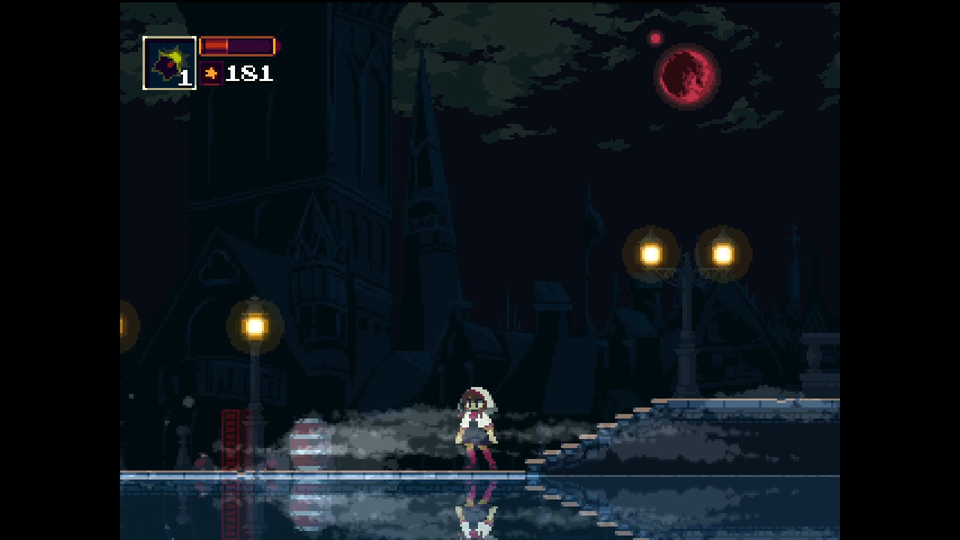
Now comes everybody's least favorite part of a review for a game I've been endlessly hyping up: when I point out its negative qualities. A few of these I've already mentioned: the short length and often frustrating difficulty. Another is that the map is monochromatic, so it can be tricky discerning which area is which when you're analyzing where you need to go. Momodora V fixes this with each area painted a unique color.
My next criticism isn't so much a flaw in the game so much as an improvement I think can be made with two of its areas, the first of which being the memorial park I mentioned earlier. I said its music invites you to simply soak in the somber atmosphere, and I think this area would've been better had the gameplay done just that. Rather than dropping in enemies like the game's scared the player will get bored, the park acts as a reprieve from all the dangers spread across the city, where maybe the city's last lucky survivors have gathered for safety, but, this being a memorial park, there's this lingering mood that these people won't even be memories by sunrise. Then there could be this miniature story where baddies break in, including the boss, and the protagonist has to fend them off to protect the people, but her efforts are only so successful.
The second area I think could do with a rework is a hidden grove in the forest where passing through a barrier separates your soul from your body. Conceptually, it's really cool. Mechanically, there's zero difference from the rest of the game. Since the protagonist is just a soul here, I think this area could've spiced things up by making it a platforming challenge. Or maybe you can't hit enemies, but enemies can still hit you, so you have to negotiate your way around them, practicing your dodging techniques. Again, the concept's great. However, it's just the concept and nothing else, so it's pointless as an addition.
To end off this round of the review, we come to the ending. I've mentioned previously how the ending of Momodora IV was a mortar shell detonating my bedroom wall, but because it was a blast in line with the established tone and mood, it wasn't mere shock value. A guilt panged me, even on this replay, about the fate I was marching the protagonist to. From everything I've written, you can probably deduce the ending in under three guesses—heck, the game gives up the ghost right before the final boss battle, but I had misinterpreted the text—so it's nothing that's a new kid on the block. What I did take issue with on my replay is that after the fade-to-black after beating the final boss, text scrolls across the screen explaining what we literally just witnessed and how everyone lived happily forever after, sort of. It almost has that same whiplash as Braid, where the mechanics result in a mind-melting plot twist, but then the game falls back on having you read blocks of text to recount what you literally just witnessed.
If you edit out the text in Momodora IV, fading out directly to the credits, it would have a pronounced effect on the player as they're left there to contemplate what they just witnessed, piecing together the mission they were on and its outcome. And to keep the info the text provides, a simple textless stinger would suffice. Granted, I'm not privy to the development details. I imagine the team was running up against deadline constraints, and a simple text scroll was the best compromise to share what they wanted. Minoria managed a stinger with a minor edit to an in-game area, but I can only speculate if even that could've been squeezed into Momodora IV.
For what it has and does, Momodora: Reverie Under the Moonlight is an indie gemstone. Speaking honestly about my replay, I didn't think it would hold up the same, and my review would be a long-form of “It was good, but not as good as I remember,” but it soundly blasted my skepticism out the water. Momodora: Reverie Under the Moonlight is a poignant, beautiful, and stunning work of art, and even if you're not interested in the series as a whole but are willing to try one, Momodora: Reverie Under the Moonlight is your title. It's the best the series has to offer, hands down, bar none.
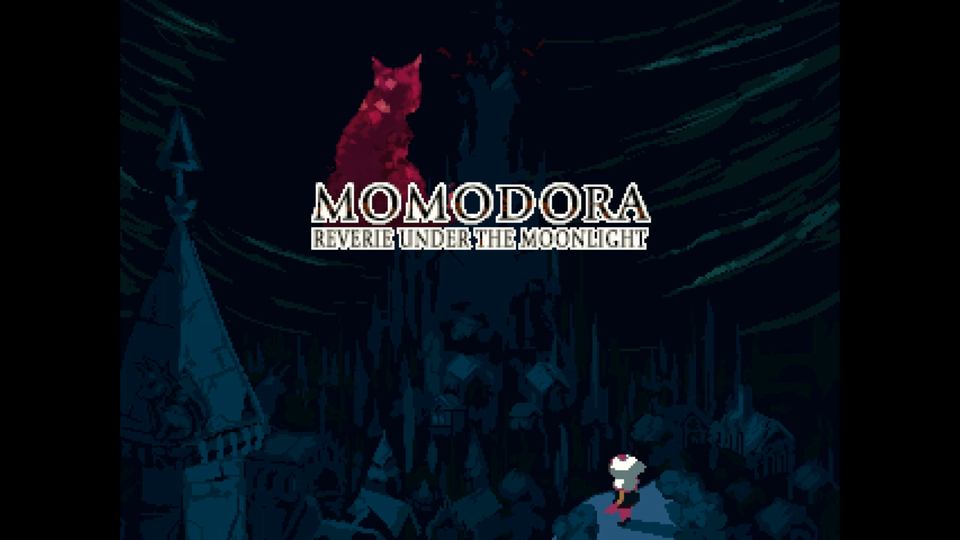
Post-Retrospective Thoughts
In the indie game sphere, the Momodora series poses for some intriguing analysis, as the series has been around for almost a decade and a half and has accumulated five titles under its belt, and one can track the upward trajectory in quality as rdein and their team learn how to improve upon each successful title. We go from stiff and awkward platforming in Momodora I to fun, fluid, and impactful combat in Momodora V.
When it comes to story and lore, however, the series is severely lacking, even after its Dark Souls-ification in Momodora IV. While one can make the argument the Momodora series is “gameplay first” or “gameplay-first” and not be inaccurate, it means my very reason for diving into the older titles in the first place, to discover the lore, was moot. Copy for Momodora V's Steam page says it's closing the book on the series's mysteries and questions, and that has more meaning than I imagine was intended because that's precisely what V does: close the book on mysteries and questions so you can't read or ponder them.
The Momodora games have so many characters and secrets that hint at something greater but that ultimately go unfinished, are cameos the creator themselves has to explain, or are so vague and tenuous in their connections that my dreams where I'm driving cross-country across a Roger Dean illustration make more sense than the theories I've read. And it's a shame because this series, despite its inability to focus or plan writing, does host some intriguing premises, such as a demon in V who, right before she dies, cries out how she wants to be reborn as a mortal. What's the deal with that? That sounds so cool. But then the narrative moves on from what's just a throwaway line.
If the writing crew strapped on their Fighting Spirit headbands and knuckled down, the Momodora games could sit in the ranks with titles like The Legend of Zelda: Link's Awakening or Super Mario Galaxy or anything else Yoshiaki Koizumi had his hand in: games people love and adore to this day, not just for the fun gameplay and polished level design, but for their patches of story, however small or tucked away, that made these games' worlds and the characters inhabiting them feel just a little more alive.
Now for the age-old question when an outsider's eyeing up a multi-entry series, and that's “Where do I start?” The most popular recommendation is to start with IV, then hop to I and count the remaining numbers up (IV, I, II, III, V), as this is the chronological order.
The second option is to play the games in their release order (I, II, III, IV, V). If play orders are a difficulty setting, this one is Hard, for I is handily the worst game in the series, and starting with the worst might not inspire a burning passion to persist with the following titles, even if they do improve from here on. Though it's also a good way to, as Mark Twain put it, eat the frog now so you don't have to eat it later.
A third option is to tailor your list to whatever titles catch your fancy. If you're after the most polished games, for instance, only play the Steam-available titles (III, IV, V), or if you want to save the best for last, make IV your final game. Even though II's ending is a direct reference to I and the games frequently reference one another, each title is standalone, so there's no harm jumping around as your heart desires.
Conclusion
Coming out of this review, my feelings toward Momodora: Moonlit Farewell are more mixed than going in. Purely as a game you sit down and play on a free afternoon, it's a solid package of cultivated combat, a customizable kit with a decent array of options, and beautiful pixel art and visual effects. But when you examine its story and lore and hold it beside its contemporaries, it's outdone in just about every regard, even by its prequel. Momodora: Moonlit Farewell isn't a bad game, but it is a bastion of missed potential and decisions that are either questionable or misguided. Judging from the product copy and recent activity from the dev team, this entry marks the end of the Momodora series, and I wish this indie cult series went out on a stronger note.

Just writing about the video games that tickle my fancy when the fancy strikes.
posted by Ross Locksley on 10 Dec 2025
posted by Ross Locksley on 01 Dec 2025
posted by Ross Locksley on 28 Nov 2025
posted by Ross Locksley on 22 Nov 2025
posted by Ross Locksley on 22 Nov 2025
posted by Ross Locksley on 13 Nov 2025
posted by Ross Locksley on 07 Nov 2025
posted by Ross Locksley on 06 Nov 2025